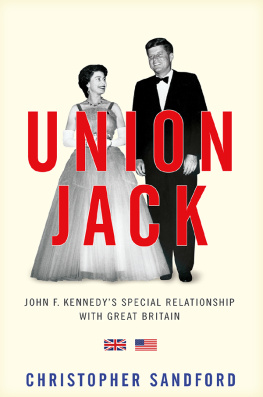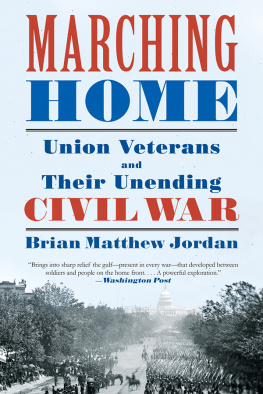1996 by The Kent State University Press, Kent, Ohio 44242
All rights reserved
Library of Congress Catalog Card Number 96-13353
ISBN 0-87338-552-7 (cloth)
ISBN-10 0-87338-853-4 (paper) ISBN-13 978-0-87338-853-5
Manufactured in the United States of America
First paper edition 2005
08 07 06 05 5 4 3 2
L IBRARY OF C ONGRESS C ATALOGING-IN -P UBLICATION D ATA
Welsh, Jack D., 1928
Medical histories of Union generals / by Jack D. Welsh
p. cm.

Includes bibiographical references (p. ).
1. United StatesHistoryCivil War, 18611865Medical care. 2. United StatesHistoryCivil War, 18611865Medical careBibliography. 3. GeneralsMedical careUnited States. 4. GeneralsMedical careUnited StatesBibliography. 5. Medicine, MilitaryUnited StatesHistory19th century. 6. Medicine, MilitaryUnited StatesHistory19th centuryBibliography. I. Title.
| E621.W44 1996 | 9613353 |
| 973.775dc20 | CIP |
British Library Cataloging-in-Publication data are available.
Three truly professional individuals help made this work possible. Dr. Richard J. Sommers, Archivist-Historian at the U.S. Army Military History Institute at the War College, Carlisle Barracks, Pennsylvania, provided not only the value of his encyclopedic knowledge of the archival material and details of events that occurred during the war but also a wonderful work atmosphere. He always seemed able to find just one more item. Michael Meier and Michael P. Musick, Military Reference Branch, Textual Reference Division, National Archives, Washington, D.C., helped me through the maze of records and found medical information filed in boxes with titles bearing little relationship to their content.
Robert Denney, author, Springfield, Virginia, and Lt. Col. Warner Rocky Farr, M.D., Fort Drum, New York, made helpful and appropriate suggestions.
Many people went out of their way to provide crucial information and missing details: Bonnie Bailey, Ft. Scott, Kansas; Patrick Brophy, Curator, Bushwhacker Museum, Nevada, Missouri; Leslie A. Cade, Reference Archivist, Center for Historical Research, Kansas State Historical Society, Topeka; Nan Card, Research Division, Rutherford B. Hayes Presidential Center, Fremont, Ohio; Suzanne Christoff, Archivist, U.S. Military Academy, West Point, New York; Mary Ann Cleveland, Librarian, Florida Collection, State Library, Tallahassee, Florida; Barbara S. Cook, Reference Librarian, McClung Historical Collection, Knox County Public Library System, Knoxville, Tennessee; Edith Eads, Logan County Genealogical Society, Bellefontaine, Ohio; Adelaide B. Elm, Head, Archives Department, Arizona Historical Society, Tucson; Frank Faulkner, Librarian, San Antonio Public Library, Texas; LeRoy H. Fischer, Oppenheim Professor of History Emeritus, Oklahoma State University, Stillwater; John T. Furlong, Associate Archivist, Missouri Historical Society at St. Louis; John R. Gonzales, Librarian, California Section, California State Library, Sacramento; Gordon O. Hendrickson, State Archivist, State Historical Society of Iowa, Des Moines; George Heerman, Reference Librarian, Illinois State Historical Library, Springfield; Earl J. Hess, Illmo, Missouri; Emily A. Herrick, Maine State Library, Augusta; Beth M. House, Special Collections, Library, Fisk University, Nashville, Tennessee; Roy Jorgensen, Fishkill Historical Society, Fishkill, New York; Marie C. Kalinoski, Secretary, Laurel Hill Cemetery Co., Philadelphia, Pennsylvania; Norwood A. Kerr, Archival Reference, State of Alabama Department of Archives and History, Montgomery; Chuck Laverty, Irishman/author, Wayne, New Jersey; Alicia Mauldin, Archives Technician, U.S. Military Academy, West Point, New York; Michael Raines, Curatorial Assistant, Harvard University Archives, Cambridge, Massachusetts; John H. Rhodehamel, Curator of American History, The Huntington Library, San Marino, California; Marvene Riss, Archivist, South Dakota State Historical Society, Pierre; David B. Sabine, Hastings-on-Hudson, New York; Ellen L. Sulser, Archives Associate, State Historical Society of Iowa, Des Moines; Thomas P. Sweeney, M.D., Republic, Missouri; William A. Veitch, Lexington, Kentucky; Eric J. Wittenberg, attorney/author, Columbus, Ohio; Martha E. Wright, Reference Librarian, Indiana Division, Indiana State Library, Indianapolis; members of The Kent State University Press, especially John Hubbell, director, who was extremely helpful in supplying battle information; and Linda Cuckovich, editor, and Diana Gordy, designer, both of whom returned to duty for this undertaking.
Sylvia B. Mason not only did the tedious work of helping find the causes of the mens deaths but repeatedly reviewed the manuscript, adding the missing commas and correcting strange sentences. She was the major source of support and encouragement and made the work more enjoyable.
While reading about the Civil War, I noted the frequent wounds, illness, and accidents that occurred to various officers. Medical events were usually mentioned because they caused an officer to leave the field or prompted a change in command. Such references contain few details, have little documentation, and provide no long-term outcome data. As a physician, I wanted to know more about these men, the details of their medical problems, and the outcome of their conditions. As was the case with the Medical Histories of the Confederate Generals, this book was prompted by my difficulties in finding details of such events that occurred during the lives of the Union generals. Only by examining each mans complete medical history can one begin to comprehend the possible effects of such experiences. As a consequence, this compilation of medical events that occurred to the Union generals provides information on a different aspect of their lives and the medicine of the period.
The 583 Union generals included in this volume were those who had met the defined criteria for inclusion by Ezra J. Warner in his book, Generals in Blue. As a consequence, they were selected as to who they were and their possible importance to the history of the period rather than because they were known to have been patients.
Since to document only what occurred to them during the Civil War would be incomplete, lifetime medical histories and causes of deaths are presented. Certain information is included because of its possible etiologic importance. For example, attendance at West Point and service in Mexico and Florida along with frontier duties are mentioned because they demonstrate prior exposure to infectious diseases, familiarity with wounds, and possible preexisting conditions. Attention is paid to their degree of being in harms way at the time they were wounded, the type of projectile, transportation from the field, and treatment, rather than to their location on the battlefield or the units involved. Certain information may appear to be insignificant but is included because it forms part of the mans complete medical history. To put the recorded events in context, a minimal amount of information on their civilian and military careers has been included. I have not speculated how their medical problems might have affected their performance or the war, as this is better left to trained military historians. However, even a brief review of the multiple illnesses and injuries resulting from wounds and accidents would suggest the possible influence poor health had on their field performance.











